A Four Decade Journey Through Hot Rodding with Jim (White) Harrell & Nick Harrell
By

A Four Decade Journey Through Hot Rodding
with Jim (White) Harrell & Nick Harrell
02-23-09
Written by Roger H. Harrell, edited by Richard Parks,
photographic consultant Roger H. Harrell & Roger Rohrdanz
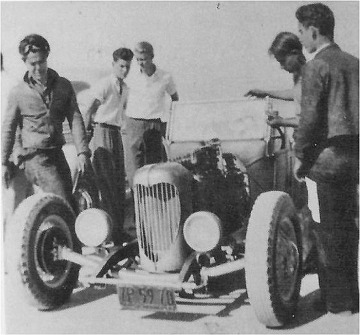 |
|
|
Jim White/Harrell (l) in 1935 at Muroc Dry Lake. |
When we speak to others of our Uncle Jim Harrell and his racing activities, one of the first questions we get is: who was Jim of Jim's Speed Shop and Jim's Auto Parts? Well, he was Jim White, J. G. White, Jim Harrell, J. G. Harrell, H. L. Harrell, and Herman L. Harrell. Jim is referred to with all these names in the racing news over a period of four decades, and they all refer to the same person. Herman Leslie (Jim) Harrell Jr was born to Herman Leslie Harrell Sr and Alice Allison. Herman Senior was born in North Carolina in 1880 and moved with his family to Madison, Georgia when he was 15. Alice Allison was born in Ohio in 1882 and moved to Waynesboro, Georgia at a young age with her family. Herman Sr and Alice both took jobs with Southern Bell Telephone and Telegraph Company. They married after high school and settled in Waynesboro until Herman Jr was born on June 3, 1903. The young family moved to Augusta, Georgia in 1904 when their second son, James Gilbert, was born and then died on June 23, 1905. Herman Sr was still working as a lineman when he moved his family to Sumter, South Carolina in 1907 where their son Nicholas was born on October 22, 1907. By the end of that year the Harrell family had moved back to Augusta. Herman Sr was still with the telephone company and all these moves were work related. The family left Augusta in 1910 and settled in Columbus, Ohio where their youngest son, Roland, was born on September 17, 1912. In 1914 the family moved to Nashville, Tennessee. Herman Sr's health was failing and he entered the county hospital in 1916, where he died in 1918 at the age of 38 of illnesses related to his service in the Spanish-American war. By that time, Herman Jr left high school and took any job that he could get to help support the family.
The next year, in 1919, Alice Harrell remarried and the three brothers went to live with their grandmother. The U.S. War Department granted the boys a pension based on their father's military-related death. Unfortunately, the pensions only applied to youngsters under the age of 16, so when Herman Jr turned sixteen, rather than burden his grandmother, he exaggerated his age a bit and joined the Navy. He was classified as a machinist in the engine room of a World War I vintage submarine. This was probably where Herman Jr acquired an affinity for powerful engines and keeping them running in top form. While Herman Jr was in the service, his mother Alice and her husband, John White, his two brothers, and grandmother settled in New Orleans. From there, they all moved to Los Angeles, California around 1921. After Herman Jr was discharged, he rejoined his family in Los Angeles in 1923 and worked as an auto mechanic around town until late 1926 when he moved back to Georgia. There he met his wife, Rachel Bonnell, and they married in 1928. 1929 saw the birth of their first daughter, Alice, and of Herman's first auto-repair shop. By February of 1930, Herman reportedly had a problem with local law enforcement, so he and his family boarded a train for Los Angeles. Herman and his family moved in with his mother and step-father, grandmother, and two younger brothers. The family home was located just west of Avalon Boulevard on 102nd Street in South Central Los Angeles. At that time, it seemed advisable for Herman to take his step-father's family name, White. His wife and daughter kept the name of Harrell. Herman had already begun to use his deceased brother's first two names of James Gilbert (some say he did this to commemorate his brother who died as an infant; others say he simply liked the names Jim Gilbert better than Herman Leslie). Just before World War II, Jim reclaimed his family name of Harrell, but he retained the first names of Jim Gilbert. However, all his legal documents carried the name of Herman L. Harrell throughout.
 |
|
|
Nick (l) and Jim Harrell at the Harrell Engines shop located at Main St. and 109th Place in South Central L.A. around 1950. The roadster was raced under the banner "Harrell Special" and was running a V8 flathead with Harrell Los Angeles heads and intake manifold. |
When Jim arrived in Los Angeles in 1930, he immediately went to work as an auto mechanic. In a short while, Jim and Rachel had their second daughter, Audrey Harrell who was born on March 10, 1931 and the growing family moved to their own place on San Pedro Street and 99th Street in Los Angeles. There was a small shop on the front of the lot which became Jim's Speed Shop in 1932. The next year Jim found a more suitable place on Main Street and 109th Place, which became both the family home and the home of Jim's Auto Parts/Jim's Speed Shop and later Harrell Engines. The Harrell shop remained in that location until Jim's death on June 28, 1976. In the early years, Jim and his speed shop specialized in building 4-cylinder Chevy engines for racing. He had one of the first re-boring shops in Los Angeles during the early 1930's and would do most of the machine and milling work for other dry lake racers like Vic Meleo who was located in walking distance from Jim's first shop. Vic had a gas station and garage on Avalon Boulevard a few streets north of Jim's Speed Shop on San Pedro Street and later on Main Street. Vic and Jim both built Chevy 4-bangers for racing and Vic had his boring, milling and machine work done at Jim's Speed Shop. Vic was about 14 years younger than Jim, nonetheless they became good friends and racing associates. In the Mid-1930's, Meleo ran at least two modifieds at the lakes most of the time. Almost without fail, Vic's cars numbered 21, 45, and 52 carried a hand painted banner reading; "Jim's Speed Shop, 11006 S. Main L.A." Vic recently explained, "That was a way to help a friend and racing buddy in those days." Just before World War II, Meleo moved his operation uptown near Pico and Central. After that, Vic and Jim mostly saw each other at the dry lakes. Vic Meleo currently lives in Lindsey, California with his son Tom.
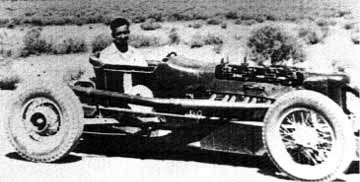 |
|
|
Tony Capanna in Jim Harrell's modified with a Hudson engine in 1941. |
Jim was also active as both a founding member of the Albata Club in 1937 and as a member of the Southern California Timing Association (SCTA) from its earliest days. Jim liked to experiment with different engines for racing, so he moved from the 4-bangers to larger engines in the late 1930's. He bought a Stutz Bearcat and Hudson straight 8 that had been run at Indy and modified them for dry lake racing. This attracted a youngster who lived up the street from Jim's shop named Tony Capanna, who was born in 1921. Jim knew Tony's family because they owned and operated Capanna's Meat Market in the neighborhood. The Harrells, the Meleos and the Berardinis, who lived around the corner from Meleo's Garage, all bought their meat from Capanna's Market. Tony started visiting Jim's shop while he was in his early teens and by the time he was in his mid-teens he was helping Jim work on engines and modify roadsters. For instance, Tony helped Jim with the Stutz engine and modifying the roadster for it. One day at the races, the Stutz engine blew. Though Jim repaired it, he never raced it again. When the Stutz engine was once again race-ready, Jim had already put his Hudson 8 into the roadster. By the time Tony was 18, he was driving Jim's Hudson at the dry lakes in 1940 and '41. Capanna also joined the Albata Club. Even though Tony was 18 years younger than Jim, early-on there was mutual admiration. Jim liked the kid's imagination, energy, and adventurous spirit. Jim's late wife, Rachel, felt Tony reminded Jim of himself when he was young. Perhaps most importantly, Jim and Tony could easily span their age difference because they were very much alike in temperament, goals, methods, and the things they admired in others. When the war came Jim became a welder and machinist at the Long Beach Shipyards, while Capanna became a welder and machinist in the shipyards at Pearl Harbor.
Jim partnered with several of his fellow Albata members, some for a year or two at a time. In 1940, Jim White and Bob Noble ran the Hudson 8 in a modified at the lakes. Also in 1940 and '41 he partnered with Bob Knapton by building a V-8 flathead engine to run in Knapton's modified. These two entries helped the Albata Club take top point honors in those pre-war years. By 1941, people were beginning to use Jim's proper last name: Harrell. When the country went to war, Jim had to officially use his legal name for security reasons at the Naval shipyards where he took a job as a machinist and welder on the night shift. While he worked nights at the ship yard, he kept his auto repair business running during the day and on the weekends. During the war he also found time to continue developing racing equipment for Ford flathead V-8 engines. At that time Jim needed help running his shop and was able to get his brother, Nick Harrell, to join him on a full-time basis. Nick Harrell had also worked as an auto mechanic by the early 1930's and often worked with Jim as door-to-door mechanics during the Depression years. Nick Joined Jim at Harrell Engines during World War II on a full-time basis and remained there until he retired in 1976. The family home on 102nd Street remained Nick's residence until he died on January 10, 1995. Nick never married or had children but he managed to sustain a close relationship with his lady-friend, Thelma, for the last 40 years of his life. Nick also had a close relationship with his two nieces, Jim's daughters, Alice (1929) and Audrey (1931), and his three nephews, Roland's sons, Richard (1934), Roger (1936), and Robert (1940-2008). Nick Harrell became an integral part of Harrell Engines for the next 25 years.
 |
|
| Jim (l) and Nick Harrell at home in 1953. | |
 |
|
| 1953, The '34 Coup is Harrell Engines', the Tudor is Tony Pollaccia's, and the Ford Roadster on the right is the Beradini Bros. All 3 engines were built by Harrell Engines and sporting Harrell Los Angeles racing heads. |
By the end of the war in 1945, Jim had developed and was machining his Harrell Los Angeles racing heads and intake manifolds for V-8 Ford and Mercury engines. Refining his racing equipment, building a new V-8 flathead for his newly acquired modified, and making the normal peace-time adjustments meant Jim was not ready to race until late in 1946. It was very fitting that when Veda Orr included in her Lakes Pictorial a photo (No. 29) of Jim's new modified in its post-war debut that it should be one that shows Capanna and Jim together picking up where they left off before the war. That was his first post-war success at Muroc Dry Lake on September 22, 1946. Jim and Nick focused on building street rods for many of the young people in the area, as well as their own roadster, known as the Harrell Special by 1950. Most of their racing took place at the Santa Ana Airport dragstrip and later at other drag strips in California with their V-8 flathead Ford and Merc engines. During the early 1950's, Harrell Engines also built many very successful engines for fellow drag racers. Most notable among them were the Berardini Brothers' 1929 & '32 roadsters. After running what Pat Berardini referred to as a "small and not very fast engine" in their '32 (later known as the 404 Jr), the Berardinis asked the Harrells' to build them something faster, which they did. Pat recently said, "After that first engine, Nick Harrell built all our engines." By the early 1950's, Nick had become the person most people saw at the shop and at the races, even though Jim continued to do all of the machine work and make the major decisions about what engines and cars to build and run. By the late 1950's, Harrell Engines partnered with Willie Borsch to put a Chrysler OHV engine in the Harrell roadster. It was referred to as the "Red Hot Roadster" in Drag News and elsewhere. This was a record setting car at several local drag strips, first unblown and on gas, and then blown on gas.
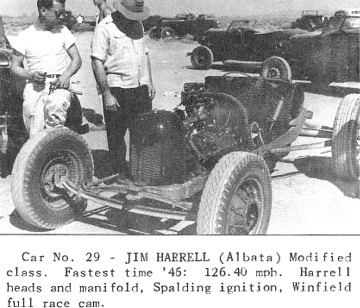 |
 |
|
| 1946 Tony Capanna (l) and Jim Harrell with his modified at El Mirage Dry Lake. | Jan. 1965 - The "Flying Wing" under the Harrell - Borsch banner. Drag Sport said "One of The Most Impressive Roadsters of All Time". |
 |
|
| The "Red Hot Roadster" running under the "Harrell Engines, L.A." banner in July 1960 as featured in "50 Years of Hot Rod" in 1998. |
By the early 1960's, the Harrell-Borsch team built an altered roadster for their blown Chrysler and within a couple of years, they were setting records in their gas class. Within a couple of more years, their yearning for even more speed had them running in the altered fuel classes. In order to stabilize the roadster, they finally had to put a large airfoil high above the rear of the altered which got the car its first nickname, The Flying Wing, and it was also a record-setting car. In late 1966, Jim Harrell told Willie he wanted to sell the altered roadster and retire from racing. Willie was far too young to retire so he teamed up with Al "Mousie" Marcellus to buy the car. The Marcellus-Borsch team ran the Winged Express for several more years with great success. With his racing years behind him, Jim fulfilled another of his long-time dreams; he attended El Camino Community College near his home in Gardena and completed the courses necessary for his high school degree. Jim and Nick continued to run Jim's Auto Parts and the Harrell Engines' shop until Jim's death in 1976. At that time, Nick went into retirement, the shop was closed and the buildings at 109th Place and Main Street were sold. Nick and his lady friend lived quietly until Nick passed away on January 10, 1995. In the late 1950's, when Jim felt the market for flathead racing equipment was very limited, he sold the patterns for his equipment to his friend, Joe "Mac" McClelland at Ford Parts Obsolete, who continued to produce several sets a year. The patterns were then passed to Dick Pickerel, Jim Desjardin, and now to Gordy Cushman in Rockford, Illinois, each of whom produced a dozen or so sets of Harrell Los Angeles heads and intake manifolds from the original patterns. Gordy is currently machining a new run of Harrell heads and manifolds.
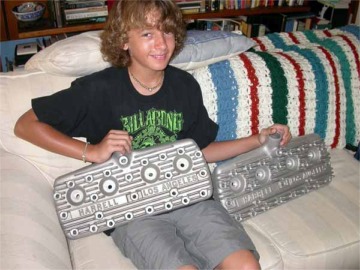 |
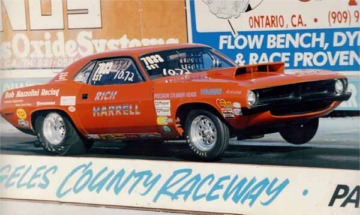 |
|
| Jim & Nick's great grandnephew, Alec R. Harrell Carlson, an Old School Hot Rodder when he received his first set of Harrell Los Angeles racing heads in 2008. | Jim & Nick's nephew, Rich Harrell, started drag racing in the early '50's and was still at it when this photo was taken around 2002. | |
 |
||
|
Jacket of the new book |
||
